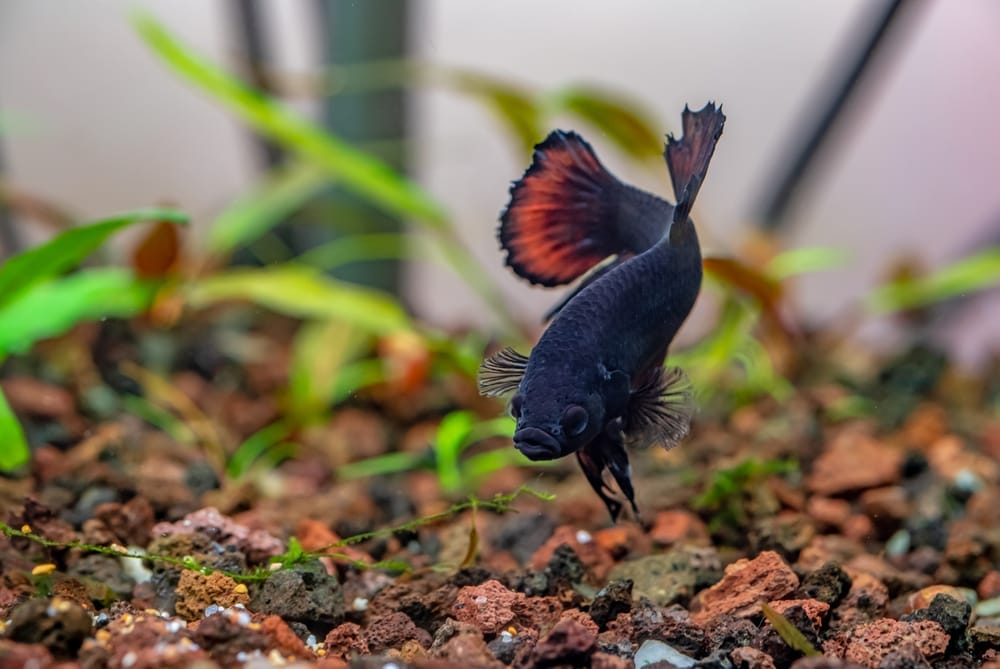This post was created with help from AI tools and carefully reviewed by a human (Muntaseer Rahman) . For more on how we use AI on this site, check out our Editorial Policy.
Check Out These FREE Tools We Made JUST For You!
How to Stop Your Betta from Jumping Out of the Tank (Lids That Work)

So you walk into your room, coffee in hand, ready to admire your beautiful betta fish doing his thing. But wait. Where is he? You scan the tank. Nothing. Then you look down and there he is, flopping on your carpet like a fish out of water (because, well, he literally is).
If this hasn’t happened to you yet, consider yourself lucky. But here’s the thing: bettas can jump 2-3 inches out of the water on average, and some overachievers have been recorded clearing 5-6 inches. For a fish that’s only a few inches long, that’s like you jumping over a two-story building.
Why Your Betta Thinks He’s an Olympic High Jumper
Before we get into the “how to stop it” part, let’s talk about why these little drama queens do this in the first place.
Poor Water Quality (The Main Culprit)
Your betta isn’t jumping for fun when the water’s bad. He’s trying to escape.
High ammonia levels, extreme pH changes, and sudden temperature shifts can cause bettas to desperately leap from their tanks in search of cleaner water. Think of it like being stuck in a room with terrible air quality. You’d want to leave too.
They’re Bored Out of Their Minds
A tank smaller than 5 gallons isn’t just cramped, it leads to boredom. And a bored betta is a jumping betta.
Your fish needs plants, decorations, and actual space to explore. Otherwise, he’s going to start looking for an exit.
Their Sleep Schedule Is Messed Up
Bettas need 8-12 hours of darkness each day to maintain a proper sleep cycle.
When they don’t get enough rest, they become disoriented and stressed. It’s like pulling an all-nighter and then trying to make good decisions. Spoiler alert: you won’t.
There’s a Bug Flying Around
In the wild, bettas jump to catch insects. If your betta sees a fly hovering over the water, he might launch himself out of the tank trying to snag it.
It’s honestly impressive. Also terrifying.
Sometimes They Just Like Jumping
Some bettas jump simply because they enjoy it, even when everything in their tank is perfect.
Female bettas seem to be more enthusiastic jumpers than males. So if you’re keeping a sorority, buckle up.
The Horror Stories Are Real
Let me paint you a picture of what can happen.
Bettas have been found hours later on the floor, covered in dust and cat hair, barely alive. Some make it through holes smaller than a dime. One person came home to find their betta had jumped through the feeding hole, which was less than an inch wide.
Outside of water, bettas can survive maybe 15 minutes in dry conditions, possibly up to 2 hours if they land in a humid spot or small puddle. But let’s be real, you don’t want to test those odds.
What Actually Works: Tank Lids That Keep Your Betta Safe
Alright, enough doom and gloom. Let’s talk solutions.
Glass Lids (The Classic Choice)
Glass lids are what most people go with, and for good reason.
They’re clear so you can still see your fish, they’re durable, and they help maintain water temperature. Glass provides excellent heat retention, which is important for tropical fish like bettas.
The downside? Most glass lids have a black strip that acts as a hinge, and this strip can block light from reaching your plants. Some people remove it entirely and just deal with two separate pieces of glass.
You can get glass lids cut at your local hardware store for around $10-15. Just bring your tank measurements and they’ll sort you out.
Plastic/Acrylic Lids
These are lighter than glass and won’t shatter if you drop them.
The drawback is they scratch easily and aren’t as heat-resistant as glass. If you’re using a heater, plastic lids can warp over time.
Mesh/Screen Lids (Maximum Airflow)
Mesh lids provide excellent airflow, which is great for bettas since they breathe air from the surface.
They’re lightweight and easy to customize. The downside? They don’t help with temperature control or evaporation like solid lids do.
DIY Solutions (When You’re Broke But Creative)
Look, I get it. Sometimes you need a lid NOW and you’re not about to drop money on something fancy.
Plastic Wrap/Cling Film
Many betta keepers use plastic wrap cut around heater cords and airline tubing, smoothing it down against the glass to prevent gaps.
Is it elegant? No. Does it work? Absolutely. Replace the plastic wrap whenever it starts to tear or lose its stick.
Pro tip: The plastic wrap also cuts down on evaporation significantly, which means fewer water top-offs.
Plastic Canvas/Craft Mesh
This is the DIY solution that actually looks decent.
You can buy clear plastic mesh (the kind used for needlepoint) at craft stores like Michael’s or Joann’s for around $3. Cut it to fit your tank, add plastic binder edges from report holders to make it look clean, and you’ve got a functional lid that allows airflow.
You can even cut a feeding hatch into it by cutting three sides of a square and attaching a ribbon or string as a handle. Your betta will learn where the food comes from and wait under the hatch when he’s hungry.
Polycarbonate Sheets
Polycarbonate from Home Depot is cheap, doesn’t warp as badly as acrylic, and you can cut it with scissors.
Light transmittance is around 90%, so your plants won’t suffer.
Other Ways to Keep Your Betta From Going Airborne
A lid is your first line of defense, but there are other things you can do.
Lower the Water Level
Keep the water level at least 2-3 inches below the top of the tank.
This gives you a buffer zone. Even if your betta decides to channel his inner dolphin, he won’t clear the edge.
Floating Plants
Floating plants like frogbit, salvinia, or water lettuce make jumping less likely by blocking the fish’s view of what’s above the water surface.
They won’t physically stop a determined jumper, but they discourage the behavior. Plus, bettas love hanging out in the roots.
Fix Your Water Quality
This is non-negotiable.
Do regular water changes (25% weekly for most tanks). Test your parameters. Make sure ammonia and nitrite are at zero. Ammonia builds up faster in smaller tanks, so if you’re keeping a betta in anything under 5 gallons, you’ll need to do water changes more frequently.
Give Your Betta a Proper Light Schedule
Turn the lights off for at least 8 hours a day so your betta can sleep.
Consistency matters here. Try to keep it on the same schedule every day so your fish’s circadian rhythm stays in check.
Keep the Tank Interesting
Plants, hiding spots, decorations. Your betta needs stuff to do. If your tank is big enough, consider adding some friendly tank mates to keep things interesting.
A bored betta is a problematic betta.
What to Do If Your Betta Jumps Out
Let’s say the worst happens and you find your betta on the floor.
Act fast. Gently pick up your fish and place him back in the tank immediately. He might look lifeless, but don’t give up. Add aquarium salt (one teaspoon per gallon) and StressCoat to help soothe his gills and heal his slime coat.
He’ll probably lay on the bottom of the tank for a while. This is normal. He’s in shock. Just keep the water clean and give him time to recover.
The biggest danger is internal injuries from hitting the floor. If he doesn’t show signs of improvement after a few hours, it might be time to prepare for the worst.
The Bottom Line
Bettas jump. That’s just what they do.
You can have the perfect tank setup and they’ll still occasionally launch themselves toward the sky for no apparent reason. But with a proper lid, you’re protecting your fish from becoming carpet jerky.
Don’t skimp on this. A $3 piece of plastic mesh or a $15 glass lid is worth it when the alternative is finding your beloved fish dried out on the floor. Trust me, you don’t want that trauma.
Cover your tank. Keep the water clean. Give your betta enough space and things to do. And maybe keep the feeding hole small enough that he can’t pull a Houdini through it.
Your betta might be dramatic, but he doesn’t deserve to die because he got too ambitious with his jumping skills.
About Author
Hello, I’m Muntaseer Rahman, the owner of AcuarioPets.com. I’m passionate about aquarium pets like shrimps, snails, crabs, and crayfish. I’ve created this website to share my expertise and help you provide better care for these amazing pets.
Disclaimer
This site is owned and operated by Muntaseer Rahman. AcuarioPets.com is a participant in the Amazon Services LLC Associates Program, an affiliate advertising program designed to provide a means for sites to earn advertising fees by advertising and linking to Amazon.com. This site also participates in other affiliate programs and is compensated for referring traffic and business to these companies.

